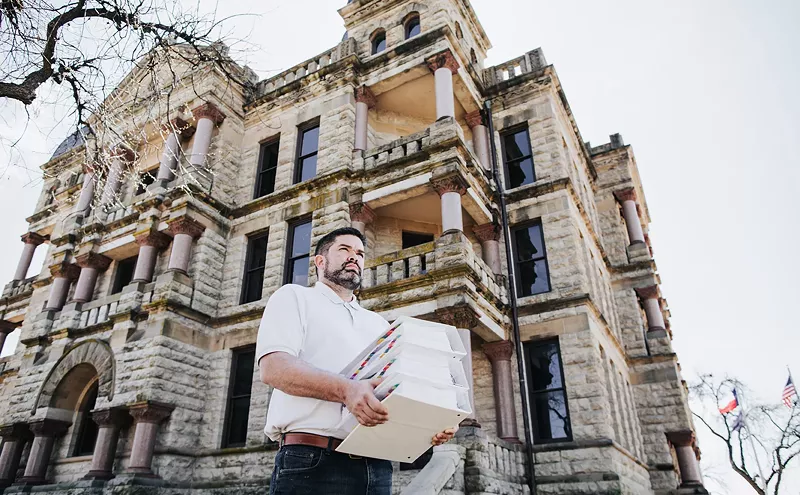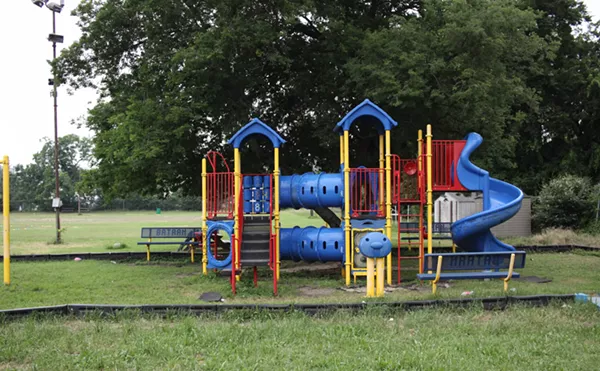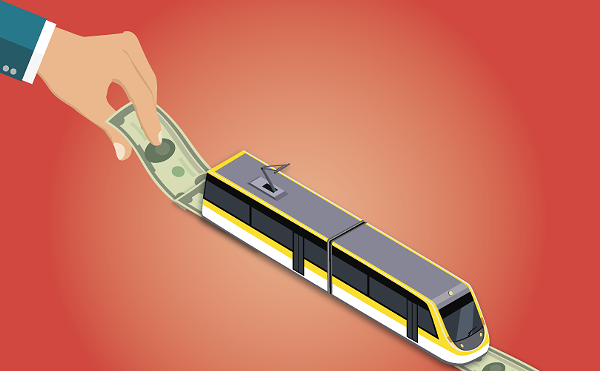With its monolithic columns at the entrance and pictorial windows of art glass, The First Presbyterian Church of Dallas in the 1800 block of Young Street is a cultural and visual landmark. One of its early homes was the first brick church in Dallas, and it grew from a single building with a dozen or so worshipers to a massive structure straight out of the Victorian era, with a congregation today of more than 1,500 people attending or streaming weekly sermons.
It'd be a shame if a rail line DART is planning to run through the south end of downtown hurt the church, but something's got to give as DART tries to snake train tracks through an area filled with hotels, historic buildings, new townhomes and Dallas Farmers Market. The question is what gives — the church or the old Statler hotel.
DART wants to run its trains down Young Street for most of downtown's second rail line. As the tracks approach downtown's southeast corner, one proposed route would have the tracks making a shift to the north, running down Jackson Street, which parallels Young but bypasses the church.
Without that shift, endorsed by the City Council and DART board, the Young Street light rail alignment would destroy the church’s parking garage, which connects to the historic building, and cause the abandonment of several classrooms and meeting rooms as well as separate the church from its homeless outreach center, according to a March 22 letter sent by John Wander, a Dallas-based attorney representing the church, to Timothy McKay, executive president of growth and regional development for Dallas Area Rapid Transit.
“This alignment would significantly and adversely affect First Presbyterian and other residents and property owners in the Farmers Market area of downtown Dallas,” Wander wrote. “We believe the selection of the Young Alignment ... would create significant issues for any DART rail expansion including, without limitation under Section 4(f) of the Department of Transportation Act, under the Texas Religious Freedom Restoration Act, and under other relevant state and federal laws.”
Council members voted 13-1 in early September for the Jackson Street alternative, and the DART board followed up with a unanimous vote for Jackson Street.
Unfortunately, trains barreling along Jackson Street would run right behind another historic building — the Statler, an iconic hotel off Commerce Street that Centurion American, one of the largest developers in North Texas, is redeveloping for $175 million.
The threat to the hotel is so significant that Centurion American CEO and President Mehrdad Moayedi sent a letter on Sept. 14 to Mayor Mike Rawlings to remind him that the historic Statler building sat empty for 15 years before a team of interested parties came together to create “an innovative financing package” that would turn the abandoned Statler building into the Statler Hilton Hotel & Residences.
The city, he pointed out, provided $46.5 million in financing incentives.
“Our preliminary analysis reveals the selection of the Jackson route could destroy most, if not all, of the increased value created by the planned $175 million redevelopment,” Moayedi wrote. “A few of the critical impacts include: loss of access for shipping and receiving, loss of parking for residential tenants, and loss of access for patrons and residents off Jackson Street."
It's not just a choice between God or mammon, either. There's history. Moayedi reminded the mayor that the Jackson Street alignment could also run afoul of “Section 4(f),” the federal law that addresses (and potentially prohibits, he claims) the taking of land from historic sites like the Statler.
He suggested that DART split the difference, sending the tracks down Wood Street, which runs east and west between Young and Jackson. He claimed that would cost less money and receive support from a majority of property owners. The church wouldn't be among that majority, however. It argues that tracks on Wood Street would run down the north side of the church a few feet from the sanctuary, making it much less sanctuary-like, presumably.
DART engineers are analyzing both routes at Young and Jackson streets, trying to determine which route is better, and despite the two votes, the church worries that key elements of the required analysis “have been overlooked or ignored," which led to its attorney sending the letter last week.
The Reverend Joseph Clifford, pastor of First Presbyterian, points out that the church has been involved with the downtown rail expansion since 2007 but fears that the position of the City Council and the DART board may be ignored.
"[But] we wouldn't want to see all the good development harmed, and they (the developer) assured us they don't want the church harmed," Clifford says.

Audio By Carbonatix
[
{
"name": "GPT - Billboard - Slot Inline - Content - Labeled - No Desktop",
"component": "21721571",
"insertPoint": "2",
"requiredCountToDisplay": "2"
},{
"name": "STN Player - Float - Mobile Only ",
"component": "21861991",
"insertPoint": "2",
"requiredCountToDisplay": "2"
},{
"name": "Editor Picks",
"component": "17105533",
"insertPoint": "4",
"requiredCountToDisplay": "1"
},{
"name": "Inline Links",
"component": "18349797",
"insertPoint": "8th",
"startingPoint": 8,
"requiredCountToDisplay": "7",
"maxInsertions": 25
},{
"name": "GPT - 2x Rectangles Desktop, Tower on Mobile - Labeled",
"component": "22608066",
"insertPoint": "8th",
"startingPoint": 8,
"requiredCountToDisplay": "7",
"maxInsertions": 25
},{
"name": "Inline Links",
"component": "18349797",
"insertPoint": "8th",
"startingPoint": 12,
"requiredCountToDisplay": "11",
"maxInsertions": 25
},{
"name": "GPT - Leaderboard to Tower - Slot Auto-select - Labeled",
"component": "17357520",
"insertPoint": "8th",
"startingPoint": 12,
"requiredCountToDisplay": "11",
"maxInsertions": 25
}
]











